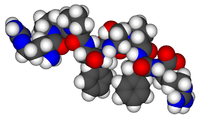
Photo from wikipedia
Smoke exposure during pregnancy has detrimental effects upon numerous fetal and neonatal outcomes. Nicotine (the main component of tobacco) has been suggested to affect placental development. During placental development, efficient… Click to show full abstract
Smoke exposure during pregnancy has detrimental effects upon numerous fetal and neonatal outcomes. Nicotine (the main component of tobacco) has been suggested to affect placental development. During placental development, efficient invasion by trophoblasts is required for establishment of the fetus–maternal circulation. In this study we explored the regulation of trophoblast invasion by nicotine. An immortalized first trimester extravillous trophoblast cell line (HTR-8/SVneo cells) was used for all the experiments, which were treated by nicotine, methyllycaconitine, and C-X-C motif chemokine ligand 12 (CXCL12). Total RNA and protein were used to study the expressions of nicotinic acetylcholine receptors (nAChRs), and transwell assay was used to study invasiveness. Changes of RNA expression due to nicotine treatment were detected by RNA sequence. Level of CXCL12 mRNA was verified by quantitative PCR. We showed that HTR-8/SVneo expressed subunits α2–4, α7, α9, β1, and β2 of nAChRs. Nicotine downregulated CXCL12 expression and inhibited trophoblast invasion. Methyllycaconitine, as an antagonist of the α7 homopolymer, blocked the inhibitory effect of nicotine. CXCL12 could rescue the nicotine-induced inhibitory effect on invasion of HTR-8/SVneo cells. These results suggest that the α7 subunit of the nAChR has important roles in modulating trophoblast invasion through CXCL12.
Journal Title: Reproductive Sciences
Year Published: 2020
Link to full text (if available)
Share on Social Media: Sign Up to like & get
recommendations!